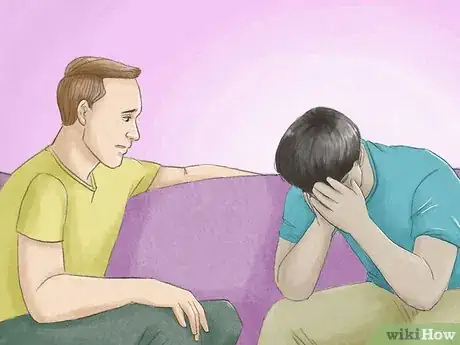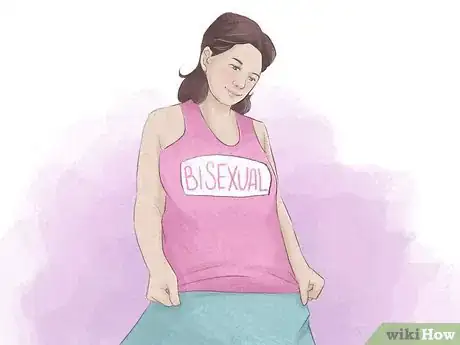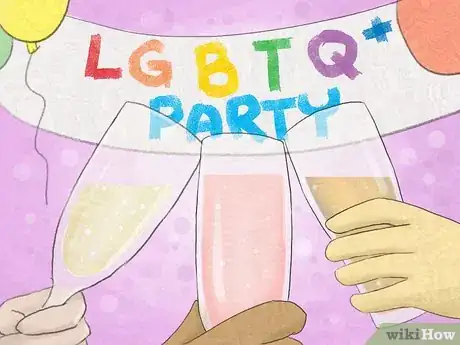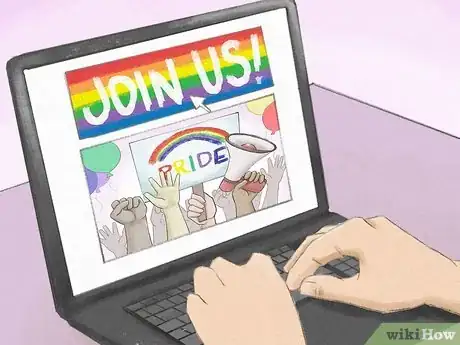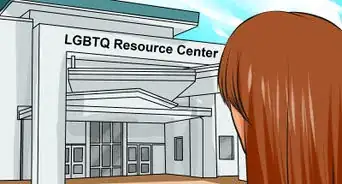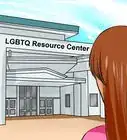This article was co-authored by Inge Hansen, PsyD and by wikiHow staff writer, Danielle Blinka, MA, MPA. Dr. Inge Hansen, PsyD, is the Director of Well-Being at Stanford University and the Weiland Health Initiative. Dr. Hansen has professional interests in social justice and gender and sexual diversity. She earned her PsyD from the California School of Professional Psychology with specialized training in the area of gender and sexual identity. She is the co-author of The Ethical Sellout: Maintaining Your Integrity in the Age of Compromise.
There are 10 references cited in this article, which can be found at the bottom of the page.
This article has been viewed 40,806 times.
Realizing you’re LGBTQ+ can be confusing at first, but it’s actually something to celebrate! To help you accept your sexuality, start by processing your thoughts and feelings about being LGBTQ+ through learning about your sexuality, journaling, and talking to people who can help. Then, embrace your sexuality by releasing self judgments, attending pro-LGBTQ+ events, and spending time with people who support you. When you’re ready, express your identity as an LGBTQ+ person.
Steps
Processing Your Emotions
-
1Look for the answers to questions you have about your sexuality. When you first realize that you may be LGBTQ+, it’s normal to have questions. Learning about sexuality and what it means to be LGBTQ+ may help you answer these questions. Read online resources to help you recognize that being LGBTQ+ is part of who you are and there’s nothing wrong with it.[1]
- For instance, you might worry that being sexually attracted to the same sex is unhealthy, but it’s actually just as healthy as being straight.[2]
-
2Keep a journal to help you work through your feelings. Writing down your thoughts and feelings helps you process them. Journal every day or when you’re feeling conflicted. Include both your positive and negative experiences to help you remember that life includes both ups and downs.[3]
- Re-read your journal periodically to see how far you’ve come.
Advertisement -
3Talk to someone you trust when you’re struggling, if possible. You don’t need to come out if you’re not ready. However, it helps to vent your feelings to someone who cares about you. Talk to a trusted friend or family member when you’re feeling overwhelmed. Tell them as much as you’re comfortable sharing. This might help you feel better.[4]
- You might say, “Right now I’m feeling really conflicted about something. I’m not comfortable talking about all of it, but I really need a friend right now.”
-
4Recognize that you are normal and can live a very happy life. Members of the LGBTQ+ community find partners, have families, thrive in their careers, and can enjoy all of life's ups and downs just like anyone else. Watch coming out stories on YouTube, as well as read coming out advice on the internet. Being LGBTQ+ is part of your identity, and you were born this way. You deserve to live a happy life as your authentic self![5]
- While you might have negative experiences because of your sexuality, it’s important to remember that you’ll also have positive experiences. Try to focus on the good things in your life instead of the bad things.
EXPERT TIPDr. Inge Hansen, PsyD, is the Director of Well-Being at Stanford University and the Weiland Health Initiative. Dr. Hansen has professional interests in social justice and gender and sexual diversity. She earned her PsyD from the California School of Professional Psychology with specialized training in the area of gender and sexual identity. She is the co-author of The Ethical Sellout: Maintaining Your Integrity in the Age of Compromise.Clinical Psychologist
 Inge Hansen, PsyD
Inge Hansen, PsyD
Clinical PsychologistOur Expert Agrees: The full spectrum of genders and sexual or romantic identities are healthy and worthy of love and acceptance, although you may receive different messages if you are queer, trans, or non-binary. It can be helpful to critically examine some of the negative messages you've heard about your identity, as well as to find sources for more supportive voices in your life. The new messages could come from a therapist, a close friend or ally, chosen family, books, articles, or more.
-
5Give yourself as much time as you need to label your sexuality. Don’t feel rushed to label yourself as LGBTQ+ or to choose a specific sexuality, such as bisexual. Take as much time as you need to decide which labels you prefer if you want to use any. When you’re ready, decide what feels right to you and know that you can change it at anytime.[6]
- For instance, you might decide that you think you’re bisexual. However, it’s okay to decide later that you’re gay. It’s totally okay to change your label.
EXPERT TIPDr. Inge Hansen, PsyD, is the Director of Well-Being at Stanford University and the Weiland Health Initiative. Dr. Hansen has professional interests in social justice and gender and sexual diversity. She earned her PsyD from the California School of Professional Psychology with specialized training in the area of gender and sexual identity. She is the co-author of The Ethical Sellout: Maintaining Your Integrity in the Age of Compromise.Clinical Psychologist
 Inge Hansen, PsyD
Inge Hansen, PsyD
Clinical PsychologistBe patient with yourself. Self-acceptance can take some time, especially if you were raised in a homophobic or transphobic environment. It took time to learn the negative messages, and it will take a while to unlearn them, too.
-
6See a therapist if you’re having trouble processing your feelings. If you’re having trouble accepting yourself, it may help to see a therapist. Your therapist can help you process your thoughts and feelings. They’ll also help you learn how to accept and love yourself. Ask your doctor to refer you to a therapist or look for one online.[7]
- You may be able to find a therapist who is LGBTQ+.
- Your therapy appointments may be covered by insurance, so check your benefits.
Embracing Your Sexuality
-
1Release self judgement to find peace with yourself. You might be having trouble accepting you sexuality because of what you’ve been taught about sexuality. This is really common, and it’s hard to overcome. Confront the judgments you’re making about yourself with loving kindness and facts about sexuality. Approach yourself with kindness and acceptance of who you are.[8]
- For instance, you may have been taught that being LGBTQ+ is a sin. While some people believe that, more and more people are starting to understand that sexuality is naturally fluid.
-
2Attend a pro-LGBTQ+ event to help you feel positive about your sexuality. Meeting other people in the LGBTQ+ community might help you feel more comfortable with your sexuality. Start going to events as an ally until you’re ready to come out of the closet. Talk to the people you meet and learn about their experiences. Spend more time around people who make you feel positive about being LGBTQ+.[9]
- If you feel comfortable, share with them that you’re also LGBTQ+ or questioning but that you’re not out yet.
- For instance, you might attend a Pride event, a Meetup for the LGBTQ+ community, or a support group.
-
3Build a support network of people who build you up. A good support network will include friends, family, and other members of the LGBTQ+ community. Choose people who accept you as you are and boost your mood. Spend time with your support network to remind yourself that you’re loved.[10]
- You might be able to find friends by attending LGBTQ+ events and businesses, including Pride.
- If you’re religious or spiritual, look for a community that supports who you are. You may be able to find a religious leader in your faith who is open to everyone, including LGBTQ+ people.
EXPERT TIPDr. Inge Hansen, PsyD, is the Director of Well-Being at Stanford University and the Weiland Health Initiative. Dr. Hansen has professional interests in social justice and gender and sexual diversity. She earned her PsyD from the California School of Professional Psychology with specialized training in the area of gender and sexual identity. She is the co-author of The Ethical Sellout: Maintaining Your Integrity in the Age of Compromise.Clinical Psychologist
 Inge Hansen, PsyD
Inge Hansen, PsyD
Clinical PsychologistFinding an accepting community is one of the most powerful steps you can take toward self-acceptance. Sometimes this community is something you can find or create in real life through affinity groups or local organizations and events. Other times, it will need to be a virtual community that you find online. Either way, the goal is to find others who share your identities (or something close), and who accept you and help you feel less alone.
-
4Minimize the time you spend with people who don’t accept you. Unfortunately, some of your friends and family members may refuse to accept your LGBTQ+ identity. This can be super painful, but it’s important to remember that it’s not your fault. When possible, remove these individuals from your life so that their negativity doesn’t bring you down. If the person is a loved one, limit your visits with them.[11]
- For instance, let’s say your aunt refuses to accept your identity. You might choose to see her only at holiday events.
-
5Follow social media accounts that feature pro-LGBTQ+ content. Look for accounts that interest you and hit follow. Seeing posts from others LGBTQ+ people reminds you that you aren’t alone. Additionally, it may help you learn more about what it means to be LGBTQ+ and how you can live your best life. Scroll through their posts when you need a boost.[12]
- If someone's content makes you feel uncomfortable or is divisive, remember that you can unfollow, report, or block their content.
-
6Enjoy pro-LGBTQ+ movies, TV shows, and books. Fortunately, you can find a wide array of content that features LGBTQ+ characters. This can help you realize that your experiences are common and it’s okay to celebrate who you are. Look for content that features characters you like and identify with.[13]
- Ignore content that mocks the LGBTQ+ community or focuses on stereotypes. You don't need that kind of negativity in your life!
Expressing Your Sexual Identity
-
1Come out to friends and family when you’re ready. Take as long as you need to feel comfortable coming out. When you feel the time is right, tell your closest friends and family members. Then, share your sexual identity with everyone else. Make the coming out process about you and do what makes you feel comfortable.[14]
- You might choose to tell a few people at a time, or you may decide to host a big party or post it on social media so everyone finds out at once.
- If you’re not ready to come out, try coming out on an online support network. Be sure to use a screen name for safety purposes.
- Don’t come out if it puts your health or safety at risk. If your parents or the person supporting you may be potentially abusive or might kick you out of the house, don’t tell them until you’re in a safe situation.
Tip: Test the waters before coming out if you're not sure how your friends and family feel about LGBTQ+ people. Try bringing up current events or pop culture that involves LGBTQ+ people or rights and seeing how they react.
-
2Be yourself and ignore the stereotypes. Unfortunately, there are a lot of stereotypes about what it means to be LGBTQ+. However, there’s no one way to be. Dress however you like, walk and talk in a way that feels comfortable to you, and love who you want. Your life is yours, and you don’t need to model yourself after someone else to be part of the LGBTQ+ community.[15]
- As an example, you might have seen stereotypes of gay men as feminine and lesbian women as butch. Similarly, you might think of trans women as dressing a certain way. All of this is stereotyping, and it’s not a true reflection of how real, everyday LGBTQ+ people live.
-
3Participate in pride events to celebrate who you are. June is Pride Month in the United States, but you may find pride events at other times of the year and in other places. Pride helps you remember that being LGBTQ+ isn’t something to hide or be ashamed about. It’s who you are, and you deserve to feel loved and accepted. Look for pride events near you so that you can celebrate being LGBTQ+.[16]
- It’s fun to dress up for pride, but you can also wear normal street clothes. Pick what makes you feel comfy.
Tip: You might also join clubs and Meetups related to the LGBTQ+ community. They’ll likely host events and socials that you can attend.
-
4Participate in pro-LGBTQ+ activism if you feel ready. While the LGBTQ+ community is making great strides in gaining equal rights and acceptance, there’s still a lot of work to do, especially from a global aspect. When you feel ready, consider becoming an activist. There are tons of ways you can help. Here are some ideas:[17]
- Donate to activist groups.
- Volunteer for an activist group.
- Write your lawmaker to promote pro-LGBTQ+ issues.
- Join or lead a protest against discrimination.
- Write for pro-LGBTQ+ publications.
- Educate the people in your life about LGBTQ+ issues.
Warnings
- Each individual's experience differs greatly. Do what is safe in your situation and only when you are prepared to do so.⧼thumbs_response⧽
References
- ↑ https://www.washington.edu/counseling/thinking-of-coming-out/
- ↑ https://www.apa.org/research/action/gay
- ↑ https://www.urmc.rochester.edu/encyclopedia/content.aspx?ContentID=4552&ContentTypeID=1
- ↑ https://lgbt.ie/wp-content/uploads/2018/06/attachment_233_Look_after_your_mental_health.pdf
- ↑ https://www.washington.edu/counseling/thinking-of-coming-out/
- ↑ https://www.washington.edu/counseling/thinking-of-coming-out/
- ↑ https://www.wellandgood.com/good-advice/lgbt-therapist/
- ↑ http://www.oprah.com/spirit/how-to-accept-your-sexuality-ask-deepak
- ↑ https://www.washington.edu/counseling/thinking-of-coming-out/
- ↑ https://lgbt.ie/wp-content/uploads/2018/06/attachment_233_Look_after_your_mental_health.pdf
- ↑ https://www.ncbi.nlm.nih.gov/pmc/articles/PMC4337813/
- ↑ https://www.ncbi.nlm.nih.gov/pmc/articles/PMC4276565/
- ↑ https://www.ncbi.nlm.nih.gov/pmc/articles/PMC4276565/
- ↑ https://www.washington.edu/counseling/thinking-of-coming-out/
- ↑ https://www.pride.com/identities/2019/6/14/10-things-you-learn-about-yourself-queer-community-during-pride#media-gallery-media-1
- ↑ https://www.pride.com/identities/2019/6/14/10-things-you-learn-about-yourself-queer-community-during-pride#media-gallery-media-9
- ↑ https://www.pride.com/identities/2019/6/14/10-things-you-learn-about-yourself-queer-community-during-pride#media-gallery-media-9
- ↑ https://www.pride.com/identities/2019/6/14/10-things-you-learn-about-yourself-queer-community-during-pride#media-gallery-media-1


